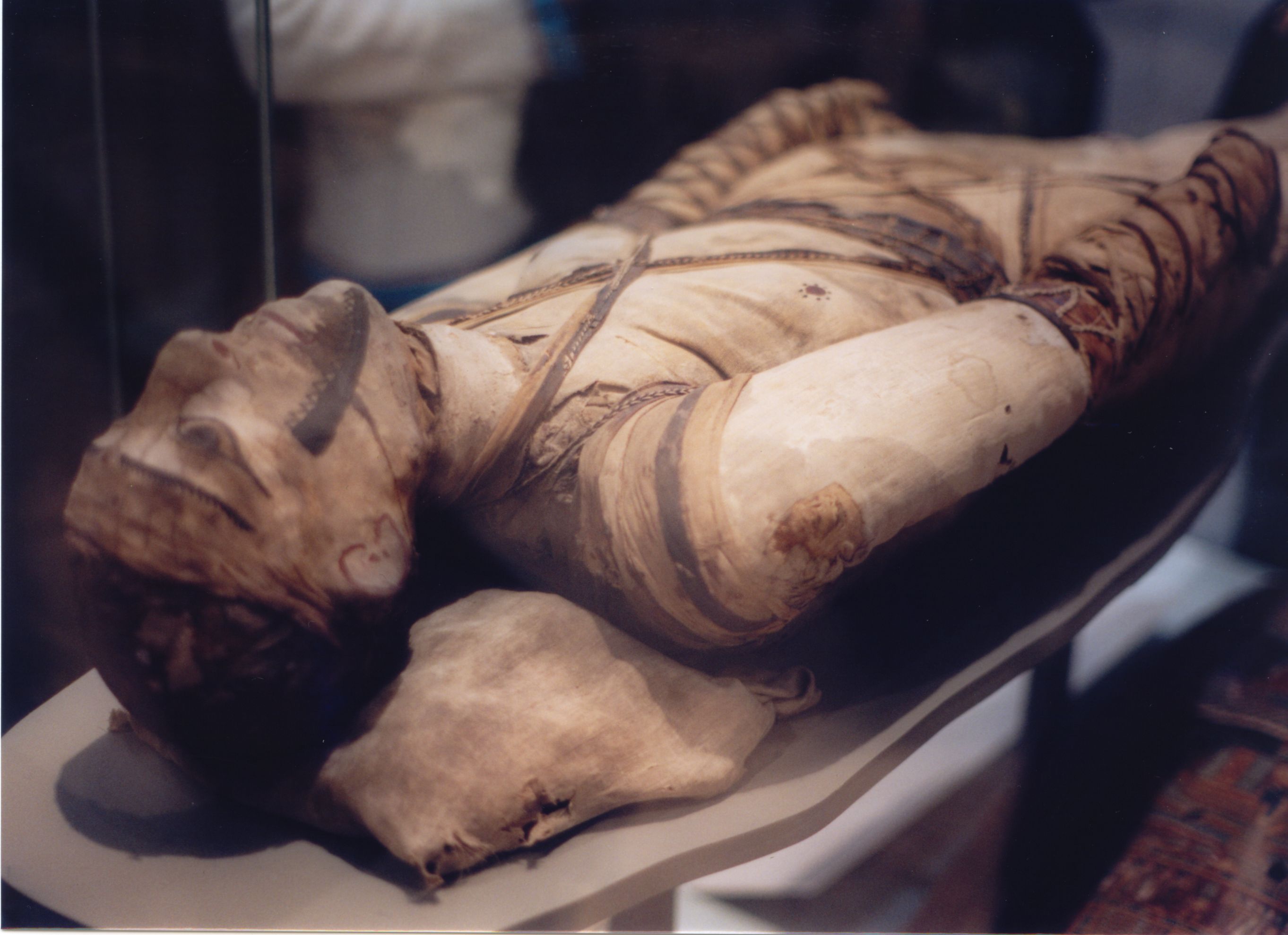|
Siberian Ice Maiden
The Siberian Ice Maiden, also known as the Princess of Ukok (russian: –Я—А–Є–љ—Ж–µћБ—Б—Б–∞ –£–Ї–ЊћБ–Ї–∞), the Altai Princess (russian: –Р–ї—В–∞–є—Б–Ї–∞—П –њ—А–Є–љ—Ж–µ—Б—Б–∞), Devochka and Ochy-bala (russian: –Ю—З—Л-–±–∞–ї–∞, the heroine of the Altaic epic), is a mummy of a woman from the 5th century BC, found in 1993 in a kurgan of the Pazyryk culture in Republic of Altai, Russia. It was among the most significant Russian archaeological findings of the late 20th century. In 2012 she was moved to a special mausoleum at the Republican National Museum in Gorno-Altaisk. Introduction The mummified remains of the Ice Maiden, a Scytho-Siberian woman who lived on the Eurasian Steppes in the 5th century BC, were found undisturbed in a subterranean burial chamber. Natalia Polosmak and her team discovered the Ice Maiden during the summer of 1993, when she was a senior research fellow at the Russian Institute of Archaeology and Ethnography in Novosibirsk. It was Polosmak's fourth season ... [...More Info...] [...Related Items...] OR: [Wikipedia] [Google] [Baidu] |
Mummy Of The Ukok Princess
A mummy is a dead human or an animal whose soft tissues and organs have been preserved by either intentional or accidental exposure to chemicals, extreme cold, very low humidity, or lack of air, so that the recovered body does not decay further if kept in cool and dry conditions. Some authorities restrict the use of the term to bodies deliberately embalmed with chemicals, but the use of the word to cover accidentally desiccated bodies goes back to at least 1615 AD (see the section Etymology and meaning). Mummies of humans and animals have been found on every continent, both as a result of natural preservation through unusual conditions, and as cultural artifacts. Over one million animal mummies have been found in Egypt, many of which are cats. Many of the Egyptian animal mummies are sacred ibis, and radiocarbon dating suggests the Egyptian Ibis mummies that have been analyzed were from time frame that falls between approximately 450 and 250 BC. In addition to the mummies ... [...More Info...] [...Related Items...] OR: [Wikipedia] [Google] [Baidu] |
Larch
Larches are deciduous conifers in the genus ''Larix'', of the family Pinaceae (subfamily Laricoideae). Growing from tall, they are native to much of the cooler temperate northern hemisphere, on lowlands in the north and high on mountains further south. Larches are among the dominant plants in the boreal forests of Siberia and Canada. Although they are conifers, larches are deciduous trees that lose their needles in the autumn. Etymology The English name Larch ultimately derives from the Latin "larigna," named after the ancient settlement of Larignum. The story of its naming was preserved by Vitruvius: It is worth while to know how this wood was discovered. The divine Caesar, being with his army in the neighbourhood of the Alps, and having ordered the towns to furnish supplies, the inhabitants of a fortified stronghold there, called Larignum, trusting in the natural strength of their defences, refused to obey his command. So the general ordered his forces to the assault. In ... [...More Info...] [...Related Items...] OR: [Wikipedia] [Google] [Baidu] |
Mummies
A mummy is a dead human or an animal whose soft tissues and organs have been preserved by either intentional or accidental exposure to chemicals, extreme cold, very low humidity, or lack of air, so that the recovered body does not decay further if kept in cool and dry conditions. Some authorities restrict the use of the term to bodies deliberately embalmed with chemicals, but the use of the word to cover accidentally desiccated bodies goes back to at least 1615 AD (see the section Etymology and meaning). Mummies of humans and animals have been found on every continent, both as a result of natural preservation through unusual conditions, and as cultural artifacts. Over one million animal mummies have been found in Egypt, many of which are cats. Many of the Egyptian animal mummies are sacred ibis, and radiocarbon dating suggests the Egyptian Ibis mummies that have been analyzed were from time frame that falls between approximately 450 and 250 BC. In addition to the mummies of ... [...More Info...] [...Related Items...] OR: [Wikipedia] [Google] [Baidu] |
Archaeology Of Siberia
The Prehistory of Siberia is marked by several archaeologically distinct cultures. In the Chalcolithic, the cultures of western and southern Siberia were pastoralists, while the eastern taiga and the tundra were dominated by hunter-gatherers until the Late Middle Ages and even beyond. Substantial changes in society, economics and art indicate the development of nomadism in the Central Asian steppes in the first millennium BC. History of research Scholarly research of the archaeological background of the region between the Urals and the Pacific began in the reign of Peter the Great (1682-1725), who ordered the collection of Scythian gold hoards and thereby rescued the contents of several robbed graves before they were melted down. During his reign, several expeditions were charged with the scientific, anthropological and linguistic research of Siberia, including the Second Kamchatka Expedition of the Dane Vitus Bering (1733-1743). Scholars also took an interest in archaeology and ... [...More Info...] [...Related Items...] OR: [Wikipedia] [Google] [Baidu] |
Archaeology Of Russia
Russian archaeology begins in the Russian Empire in the 1850s and becomes Soviet archaeology in the early 20th century. The journal ''Sovetskaya arkheologiya'' is published from 1957. Archaeologists Sites major archaeological cultures and sites in Russia ** Kermek ( :ru:–Ъ–µ—А–Љ–µ–Ї (—Б—В–Њ—П–љ–Ї–∞)) ** Bogatyri/Sinyaya Balka ( :ru:–С–Њ–≥–∞—В—Л—А–Є/–°–Є–љ—П—П –±–∞–ї–Ї–∞) ** Palaeolithic site Kostyonki **Sungir Sungir (, sometimes spelled Sunghir) is an Upper Paleolithic archaeological site in Russia and one of the earliest records of modern ''Homo sapiens'' in Eurasia. It is situated about two hundred kilometres east of Moscow, on the outskirts of Vlad ... **Yana Rhinoceros Horn Site, Yana RHS (:ru:–ѓ–љ—Б–Ї–∞—П —Б—В–Њ—П–љ–Ї–∞) **Afontova Gora *Mal'taвАУBuret' culture (Upper Paleolithic) *Khvalynsk culture (Eneolithic) *FatyanovoвАУBalanovo culture (Chalcolithic) *Novotitorovka culture (Early Bronze Age) *Maykop culture (Early Bronze Age) **Maykop kurgan *Yamna culture *Afa ... [...More Info...] [...Related Items...] OR: [Wikipedia] [Google] [Baidu] |
1993 Archaeological Discoveries
File:1993 Events Collage.png, From left, clockwise: The Oslo I Accord is signed in an attempt to resolve the IsraeliвАУPalestinian conflict; The Russian White House is shelled during the 1993 Russian constitutional crisis; Czechoslovakia is peacefully dissolved into the Czech Republic and Slovakia; In the United States, the ATF besieges a compound belonging to David Koresh and the Branch Davidians in a search for illegal weapons, which ends in the building being set alight and killing most inside; Eritrea gains independence; A major snow storm passes over the United States and Canada, leading to over 300 fatalities; Drug lord and narcoterrorist Pablo Escobar is killed by Colombian special forces; Ramzi Yousef and other Islamic terrorists detonate a truck bomb in the subterranean garage of the North Tower of the World Trade Center in the United States., 300x300px, thumb rect 0 0 200 200 Oslo I Accord rect 200 0 400 200 1993 Russian constitutional crisis rect 400 0 600 200 Dissol ... [...More Info...] [...Related Items...] OR: [Wikipedia] [Google] [Baidu] |
Mummy
A mummy is a dead human or an animal whose soft tissues and organs have been preserved by either intentional or accidental exposure to chemicals, extreme cold, very low humidity, or lack of air, so that the recovered body does not decay further if kept in cool and dry conditions. Some authorities restrict the use of the term to bodies deliberately embalmed with chemicals, but the use of the word to cover accidentally desiccated bodies goes back to at least 1615 AD (see the section Etymology and meaning). Mummies of humans and animals have been found on every continent, both as a result of natural preservation through unusual conditions, and as cultural artifacts. Over one million animal mummies have been found in Egypt, many of which are cats. Many of the Egyptian animal mummies are sacred ibis, and radiocarbon dating suggests the Egyptian Ibis mummies that have been analyzed were from time frame that falls between approximately 450 and 250 BC. In addition to the mummies ... [...More Info...] [...Related Items...] OR: [Wikipedia] [Google] [Baidu] |
Kurgan
A kurgan is a type of tumulus constructed over a grave, often characterized by containing a single human body along with grave vessels, weapons and horses. Originally in use on the PonticвАУCaspian steppe, kurgans spread into much of Central Asia and Eastern, Southeast, Western and Northern Europe during the 3rd millennium BC. The earliest kurgans date to the 4th millennium BC in the Caucasus, and a part of researchers associate these with the Indo-Europeans. Kurgans were built in the Eneolithic, Bronze, Iron, Antiquity and Middle Ages, with ancient traditions still active in Southern Siberia and Central Asia. Etymology According to the Etymological dictionary of the Ukrainian language the word "kurhan" is borrowed directly from the "Polovtsian" language ( Kipchak, part of the Turkic languages) and means: fortress, embankment, high grave. The word has two possible etymologies, either from the Old Turkic root ''qori-'' "to close, to block, to guard, to protect", or ''qur-'' "t ... [...More Info...] [...Related Items...] OR: [Wikipedia] [Google] [Baidu] |
Eurasian Steppes
The Eurasian Steppe, also simply called the Great Steppe or the steppes, is the vast steppe ecoregion of Eurasia in the temperate grasslands, savannas and shrublands biome. It stretches through Hungary, Bulgaria, Romania, Moldova and Transnistria, Ukraine, Western Russia, Siberia, Kazakhstan, Xinjiang, Mongolia and Manchuria, with one major exclave, the Pannonian steppe or Puszta, located mostly in Hungary. Since the Paleolithic age, the Steppe Route has connected Central Europe, Eastern Europe, Western Asia, Central Asia, East Asia and South Asia economically, politically and culturally through overland trade routes. The Steppe route is a predecessor not only of the Silk Road which developed during antiquity and the Middle Ages, but also of the Eurasian Land Bridge in the modern era. It has been home to nomadic empires and many large tribal confederations and ancient states throughout history, such as the Xiongnu, Scythia, Cimmeria, Sarmatia, Hunnic Empire, Chorasmia, Transox ... [...More Info...] [...Related Items...] OR: [Wikipedia] [Google] [Baidu] |
Kim Trainor
Kim Trainor is a Canadian poet. Trainor was the recipient of the Fiddlehead's 2019 Ralph Gustafson Prize and the Malahat Review's 2013 Long Poem Prize. Trainor's work is particularly concerned with grief and memory. Her first book ''Karyotype'' was published by Brick Books in 2015. George Elliot Clarke described the book as a "recollection of the organized violence that is war and/or tyranny" and noted that the book's focus on remembrance placed her in the lineage of World War One poet John McCrae. Trainor's second book ''Ledi'' was published by Book*hug. Focusing on the controversial excavation of the Siberian Ice Maiden, the book continues the poet's elegiac themes, with a focus on the Iron Age horsewoman's role in society. The book was a finalist for the 2019 Raymond Souster Award presented by the League of Canadian Poets. Her most recent work has focused on ecological grief and resilience. ''A thin fire runs through me'' will appear with icehouse poetry ( Gooselane Editions) ... [...More Info...] [...Related Items...] OR: [Wikipedia] [Google] [Baidu] |
State Prize Of The Russian Federation
The State Prize of the Russian Federation, officially translated in Russia as Russian Federation National Award, is a state honorary prize established in 1992 following the breakup of the Soviet Union. In 2004 the rules for selection of laureates and the status of the award were significantly changed, making them closer to such awards as the Nobel Prize or the Soviet Lenin Prize.Order of President of Russian Federation N785 on reform of state awards 21 June 2004 Every year seven prizes are awarded: * Three prizes in science and technology (according to newspaper there was a fourth 2008 State Prize for Science and Technology awarded by a sp ... [...More Info...] [...Related Items...] OR: [Wikipedia] [Google] [Baidu] |








